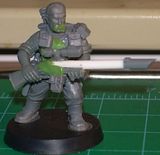 Small update this time. Once the model had dried thoroughly from the last stage (I always like to give Kleer a long time to dry), I start to apply the "flashes" and colour blocks. Any "light" areas were painted using P3 Menoth White Base in the normal way with a brush. Then i masked off the nose cone and painted the stripes using P3 Heart Fire.
Small update this time. Once the model had dried thoroughly from the last stage (I always like to give Kleer a long time to dry), I start to apply the "flashes" and colour blocks. Any "light" areas were painted using P3 Menoth White Base in the normal way with a brush. Then i masked off the nose cone and painted the stripes using P3 Heart Fire.
 Once these sections were dry, I used a sponge to apply chips in Chardon Granite. There were applied lightly, and once dry, I corrected some parts by using either more granite (where the effect was too light), or the base coat (where the effect was too much). Finally the granite marks were highlighted with white.
Once these sections were dry, I used a sponge to apply chips in Chardon Granite. There were applied lightly, and once dry, I corrected some parts by using either more granite (where the effect was too light), or the base coat (where the effect was too much). Finally the granite marks were highlighted with white.
 For the next stage, I then washed the entire vehicle with various oil colours, but starting from a base of Burnt Umber. These washes were very thin - Basically they were coloured Turpentine. This kind of wash is often called a "Filter" in AFV modelling. The next thing to be applied (once the washes had been left to dry for a couple of hours) was "spotting" - this makes the final surface much less even, and gives nice graduation to the colours (I'm planning on doing a longer post about these techniques in the near future).
For the next stage, I then washed the entire vehicle with various oil colours, but starting from a base of Burnt Umber. These washes were very thin - Basically they were coloured Turpentine. This kind of wash is often called a "Filter" in AFV modelling. The next thing to be applied (once the washes had been left to dry for a couple of hours) was "spotting" - this makes the final surface much less even, and gives nice graduation to the colours (I'm planning on doing a longer post about these techniques in the near future).
 All metal parts were then drybrushed with Tin Bitz (or whatever the vallejo equivalent is called), followed by a dry brush with Chainmail. Once those layers were dry, the metal areas then got a dry brush of neat Burnt Umber and Black oil paints, to bring the metallic effect down a bit and to give them a "harder" look. Finally i recoated any areas that wold be solid black on the final model - The intakes for the boosters as the under carriage / landing gear.
All metal parts were then drybrushed with Tin Bitz (or whatever the vallejo equivalent is called), followed by a dry brush with Chainmail. Once those layers were dry, the metal areas then got a dry brush of neat Burnt Umber and Black oil paints, to bring the metallic effect down a bit and to give them a "harder" look. Finally i recoated any areas that wold be solid black on the final model - The intakes for the boosters as the under carriage / landing gear.
The model was then set aside to dry for at least 48 hours before the next stage of weathering could take place





















0 comments:
Post a Comment